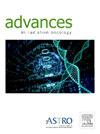Representation of Radiation Oncologists on National Comprehensive Cancer Network Guideline Committees
IF 2.7
Q3 ONCOLOGY
引用次数: 0
Abstract
Purpose
The National Comprehensive Cancer Network (NCCN) guideline committees (GCs) play a vital role in defining the standard of care for cancer management. Equitable specialty representation is crucial for unbiased recommendations and perspectives. This study examines the specialty and leadership representation on NCCN GCs, with a focus on radiation oncologists (ROs).
Methods and Materials
This cross-sectional observational study evaluated committee member characteristics on NCCN treatment GCs available in 2020 and subset of committees with guidelines containing category 1 or 2A radiation therapy recommendations. Collected data included member characteristics and committee roles. Interspecialty variance was evaluated via χ2 tests.
Results
A total of 1768 NCCN committee members were identified, representing 54 NCCN GCs with a median committee size of 33 (range, 22-38). Among all members: 47.6% were medical oncologists (MOs), 20.9% were surgical oncologists (SOs), and 8.9% were RO; 22.6% were other specialists. Women accounted for 37.6% (316/841) of MO, 34.2%(54/158) of RO and 22.8% (84/369) of SO members (P < .001). RO representation varied based on disease site (2.4%-29.9%; 15 individual committees had no RO representation) and in leadership roles (3% chairs, 23% vice chairs). On 38 committees with guidelines containing category 1 or 2A radiation therapy recommendations, the pattern of low representation persisted (8.4%). Although 39% of individuals on all committees were women, only 23% of committee chairs were women (P = .048).
Conclusion
There is low representation of ROs on NCCN GCs and in leadership roles, which may limit the discussion during guideline development and negatively impact the diversity of perspectives in management recommendations.
放射肿瘤学家在国家综合癌症网络指南委员会的代表
目的:国家综合癌症网络(NCCN)指南委员会(GCs)在确定癌症管理的护理标准方面发挥着至关重要的作用。公平的专业代表性对于公正的建议和观点至关重要。本研究考察了NCCN GCs的专业和领导代表性,重点是放射肿瘤学家(ROs)。方法和材料本横断面观察性研究评估了2020年可用的NCCN治疗GCs的委员会成员特征,以及包含1类或2A类放射治疗建议指南的委员会子集。收集的数据包括成员特征和委员会角色。通过χ2检验评估专业间方差。结果共确定了1768个NCCN委员会成员,代表54个NCCN GCs,委员会规模中位数为33(范围22-38)。在所有成员中:内科肿瘤学家(MOs)占47.6%,外科肿瘤学家(SOs)占20.9%,RO占8.9%;22.6%为其他专科。MO成员中女性占37.6% (316/841),RO成员中女性占34.2%(54/158),SO成员中女性占22.8%(84/369)。措施)。RO代表因疾病部位而异(2.4%-29.9%;15个单独的委员会没有主任代表)和领导角色(3%的主席,23%的副主席)。在38个包含1类或2A类放射治疗建议指南的委员会中,低代表性的模式仍然存在(8.4%)。尽管所有委员会中39%的成员是女性,但只有23%的委员会主席是女性(P = 0.048)。结论在NCCN GCs和领导角色中,ro的代表性较低,这可能限制了指南制定过程中的讨论,并对管理建议的观点多样性产生负面影响。
本文章由计算机程序翻译,如有差异,请以英文原文为准。
求助全文
约1分钟内获得全文
求助全文
来源期刊

Advances in Radiation Oncology
Medicine-Radiology, Nuclear Medicine and Imaging
CiteScore
4.60
自引率
4.30%
发文量
208
审稿时长
98 days
期刊介绍:
The purpose of Advances is to provide information for clinicians who use radiation therapy by publishing: Clinical trial reports and reanalyses. Basic science original reports. Manuscripts examining health services research, comparative and cost effectiveness research, and systematic reviews. Case reports documenting unusual problems and solutions. High quality multi and single institutional series, as well as other novel retrospective hypothesis generating series. Timely critical reviews on important topics in radiation oncology, such as side effects. Articles reporting the natural history of disease and patterns of failure, particularly as they relate to treatment volume delineation. Articles on safety and quality in radiation therapy. Essays on clinical experience. Articles on practice transformation in radiation oncology, in particular: Aspects of health policy that may impact the future practice of radiation oncology. How information technology, such as data analytics and systems innovations, will change radiation oncology practice. Articles on imaging as they relate to radiation therapy treatment.
 求助内容:
求助内容: 应助结果提醒方式:
应助结果提醒方式:


